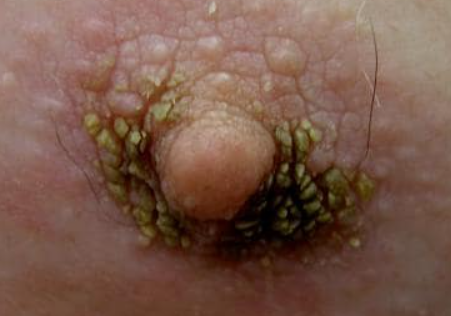Hyperkeratosis of the nipple and/or areola (nevoid hyperkeratosis of the nipple and areola) is a condition characterized by excessive keratinization of the nipple and/or areola. ICD-10 Code: D24
Hyperkeratosis of the nipple and/or areola predominantly affects women (80% of cases) between the ages of 10 and 40, more often than men. The exact etiology and pathogenesis of this condition are still unknown. There are several etiologic classifications of the disease. Levy-Frankel Classification (1938):- Type I - hyperkeratosis as a manifestation of epidermal nevus (usually unilateral).
- Type II - hyperkeratosis associated with disseminated dermatoses such as ichthyosis, acanthosis nigricans, cutaneous lymphoma, Darier's disease, etc. (usually bilateral).
- Type III - idiopathic nevoid hyperkeratosis - occurs in adolescent girls and women aged 20-40 years (usually bilateral) and progresses during pregnancy.
- Type I - primary idiopathic or nevoid hyperkeratosis occurring in girls and young women, persists throughout life without progression.
- Type II - secondary symptomatic hyperkeratosis associated with the following conditions:
- Epidermal nevus
- Nevus sebaceus
- Leiomyomas
- Warts
- Congenital, acquired, or erythrodermic ichthyosis
- Malignant acanthosis nigricans
- Darier disease
- Seborrheic keratosis
- Chronic eczema
- Cutaneous T-cell lymphoma
- Chronic candidiasis
- Pregnancy
- Hormonal (estrogenic) therapy for prostate cancer in men
- Treatment with vemurafenib
- Estrogen therapy for androgen insensitivity syndrome
- Malassezia furfur infection
It is characterized by limited unilateral or bilateral hyperkeratosis in the area of the areola and/or nipple of the mammary gland. Lesions appear as gray, yellow, dark brown, or black wart-like filamentous papules or flat thickened plaques, often with a papillomatous or "velvety" surface, either isolated or coalescing.
According to one study, involvement was found on the nipple alone in 17% of cases, on the areola alone in 25% of cases, and on both the nipple and areola in 58% of cases. The condition is usually asymptomatic, with occasional mild itching.
- Paget disease
- Basal cell carcinoma
- Bowen disease
- Nipple eczema
Topical treatment options:
- 12% cream (ointment) of lactic acid
- 6% salicylic acid ointment
- 0.025% cream (ointment) of tretinoin
- 0.05% cream (ointment) of calcipotriol
- 2% ketoconazole (cream, solution)
- 0.1% mometasone furoate cream
Systemic treatment:
- Low-dose acitretin in combination with topical calcipotriol application
- Itraconazole
Destructive methods:
- Cryotherapy
- Surgical removal of the involved part
- Surgical removal of the areola and reconstruction of the skin cover
- Laser removal
- Curettage

